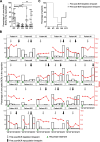Sensitive B-cell receptor repertoire analysis shows repopulation correlates with clinical response to rituximab in rheumatoid arthritis
- PMID: 38493208
- PMCID: PMC10943808
- DOI: 10.1186/s13075-024-03297-7
Sensitive B-cell receptor repertoire analysis shows repopulation correlates with clinical response to rituximab in rheumatoid arthritis
Abstract
Background: Although B-cell depleting therapy in rheumatoid arthritis (RA) is clearly effective, response is variable and does not correlate with B cell depletion itself.
Methods: The B-cell receptor (BCR) repertoire was prospectively analyzed in peripheral blood samples of twenty-eight RA patients undergoing rituximab therapy. Timepoints of achieved BCR-depletion and -repopulation were defined based on the percentage of unmutated BCRs in the repertoire. The predictive value of early BCR-depletion (within one-month post-treatment) and early BCR-repopulation (within 6 months post-treatment) on clinical response was assessed.
Results: We observed changes in the peripheral blood BCR repertoire after rituximab treatment, i.e., increased clonal expansion, decreased clonal diversification and increased mutation load which persisted up to 12 months after treatment, but started to revert at month 6. Early BCR depletion was not associated with early clinical response but late depleters did show early response. Patients with early repopulation with unmutated BCRs showed a significant decrease in disease activity in the interval 6 to 12 months. Development of anti-drug antibodies non-significantly correlated with more BCR repopulation.
Conclusion: Our findings indicate that rather than BCR-depletion it is repopulation with unmutated BCRs, possibly from naïve B cells, which induces remission. This suggests that (pre-existing) differences in B-cell turnover between patients explain the interindividual differences in early clinical effect.
Keywords: AIRR-seq; B cells; B-cell receptor repertoire; Rheumatoid arthritis; Rituximab.
© 2024. The Author(s).
Conflict of interest statement
The authors declare no competing interests.
Figures




Similar articles
-
Non-response to rituximab therapy in rheumatoid arthritis is associated with incomplete disruption of the B cell receptor repertoire.Ann Rheum Dis. 2019 Oct;78(10):1339-1345. doi: 10.1136/annrheumdis-2018-214898. Epub 2019 Jun 19. Ann Rheum Dis. 2019. PMID: 31217169 Free PMC article.
-
Correlation between cellular expression of complement regulatory proteins with depletion and repopulation of B-lymphocytes in peripheral blood of patients with rheumatoid arthritis treated with rituximab.Rev Bras Reumatol Engl Ed. 2017 Sep-Oct;57(5):385-391. doi: 10.1016/j.rbre.2016.09.007. Epub 2016 Oct 18. Rev Bras Reumatol Engl Ed. 2017. PMID: 29037309 Clinical Trial. English, Portuguese.
-
B cell repopulation kinetics after rituximab treatment in ANCA-associated vasculitides compared to rheumatoid arthritis, and connective tissue diseases: a longitudinal observational study on 120 patients.Arthritis Res Ther. 2017 May 18;19(1):101. doi: 10.1186/s13075-017-1306-0. Arthritis Res Ther. 2017. PMID: 28521808 Free PMC article.
-
Rituximab: novel B-cell depletion therapy for the treatment of rheumatoid arthritis.Expert Opin Pharmacother. 2006 Dec;7(18):2559-70. doi: 10.1517/14656566.7.18.2559. Expert Opin Pharmacother. 2006. PMID: 17150009 Review.
-
What is the role of rituximab in the treatment of rheumatoid arthritis?Autoimmun Rev. 2007 Sep;6(8):553-8. doi: 10.1016/j.autrev.2007.02.004. Epub 2007 Mar 7. Autoimmun Rev. 2007. PMID: 17854748 Review.
Cited by
-
Rituximab, Apremilast, and Upadacitinib as Selected Biosimilar and Targeted Synthetic Disease-Modifying Antirheumatic Drugs with Diverse Mechanisms of Action: Their Current Use in Slowing Down the Progression of Disease.J Clin Med. 2025 Apr 10;14(8):2605. doi: 10.3390/jcm14082605. J Clin Med. 2025. PMID: 40283434 Free PMC article. Review.
-
Rheumatoid arthritis unmasked: the power of B cell depletion therapy.Mol Biol Rep. 2025 Feb 20;52(1):254. doi: 10.1007/s11033-025-10366-w. Mol Biol Rep. 2025. PMID: 39976856 Review.
References
MeSH terms
Substances
Grants and funding
LinkOut - more resources
Full Text Sources
Medical

